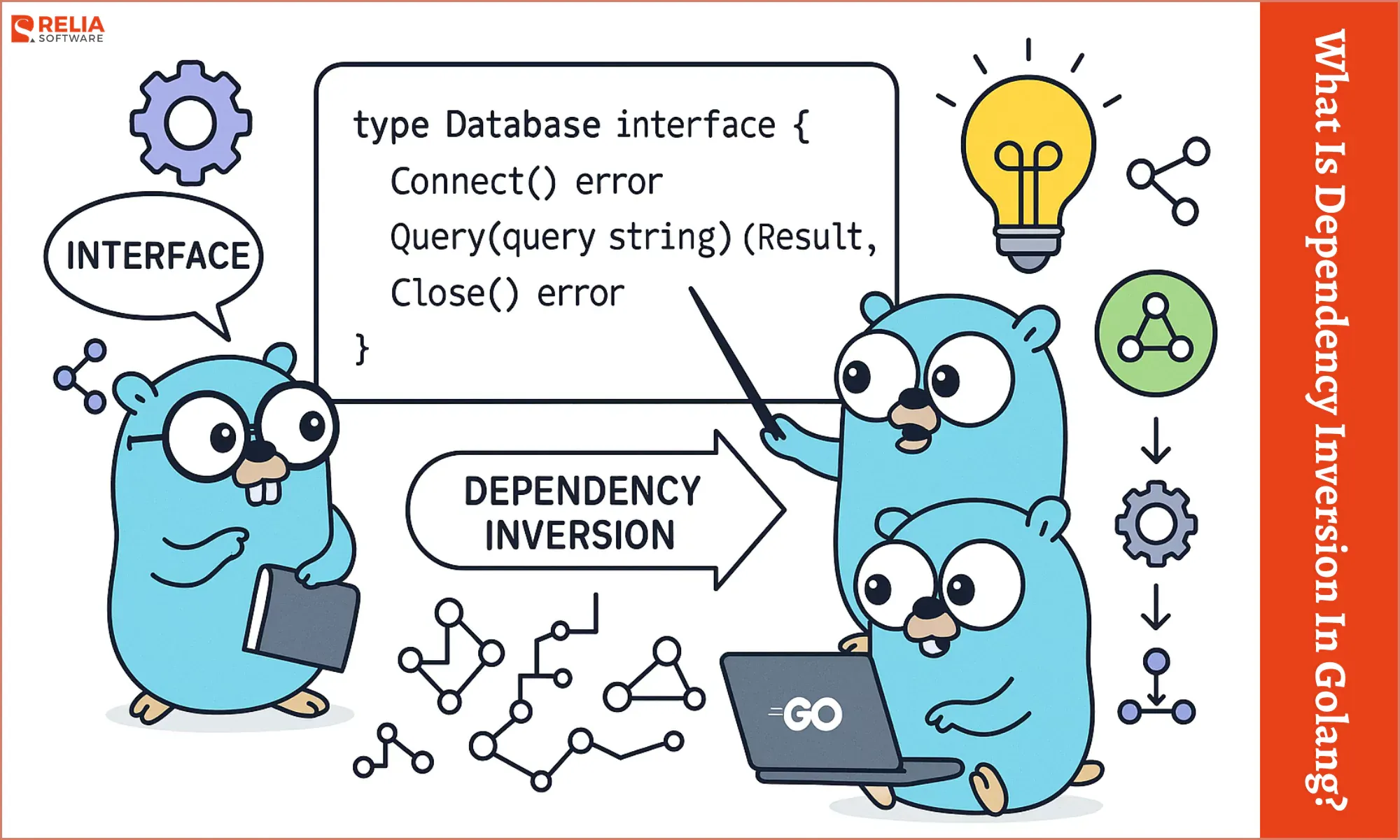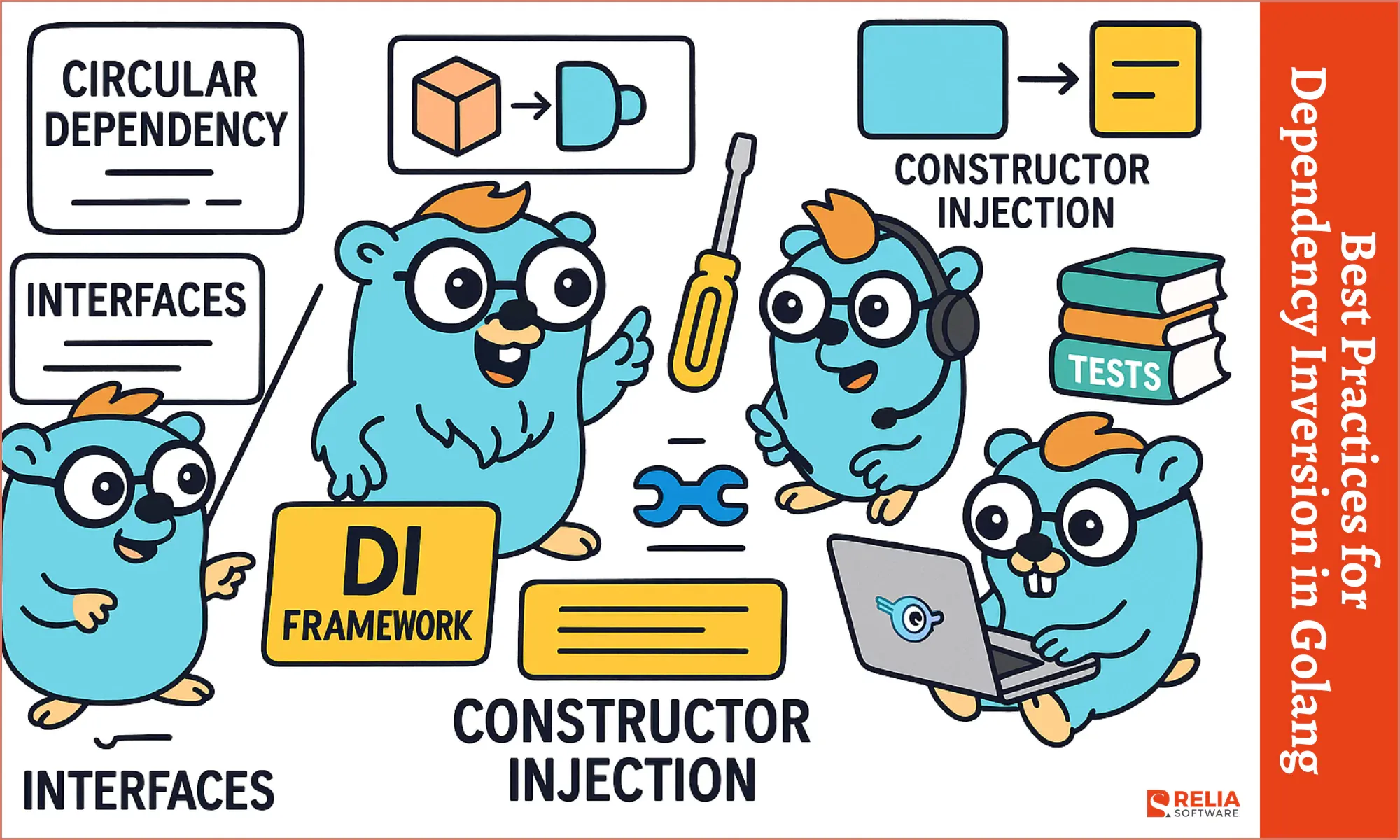Loose coupling between software parts is encouraged by the notion of dependency inversion, which is central to object-oriented programming. It allows for further flexibility and easier conservation of code, as well as better scalability and testability. In Golang, dependency inversion can be enforced using interfaces, which define a set of styles that a type must implement.
>> Read more:
- Golang Struct Mastery: Deep Dive for Experienced Developers
- How Top Companies Achieve Powerful Business Results with Golang?
- GoLang Web Development Company
What Is Dependency Inversion In Golang?
Dependency inversion is an important principle of object-oriented programming that promotes loose coupling between software factors. In Golang programming language, dependency inversion can be enforced using interfaces, which define a set of styles that a type must apply.
By using interfaces, rather than directly depending on concrete types, Golang law can be more flexible and easier to maintain. This is because interfaces allow for further inflexibility in changing the perpetration of dependences without affecting the rest of the code.
In Golang, interfaces are defined using the interface keyword, followed by a set of method signatures. For example:
type Database interface {
Connect() error
Query(query string) (Result, error)
Close() error
}This interface defines three styles that a type must apply to be considered a Database. Any type that implements these styles can be used as a dependency for functions or structs that bear a Database.
It involves passing dependencies to functions or structs as parameters, rather than creating them inside the function or struct. This allows for further flexibility in changing the dependencies without changing the function or struct.
Overall, dependency inversion is an important principle to follow in Golang to produce a more flexible and justifiable law. By using interfaces and dependency inversion, Golang developers can produce code that's easier to test and gauge, and more resistant to changes in external dependencies.
>> Read more: Type Conversion in Golang: How To Convert Data Types in Go?

Benefits of Dependency Inversion
Decoupling
The Dependency Inversion Principle eliminates direct dependencies between modules by relying on abstractions rather than concrete implementations. Because of the loose connection, individual modules can be developed and modified independently, making the system more maintainable and adaptive.
Modularity
The Dependency Inversion Principle encourages the development of well-defined interfaces or abstractions that describe the behaviors and contracts that exist between components. This modularity helps code structure, increases code reusability, and allows for the combination of many modules to create sophisticated systems.
Testability
The usage of abstractions in the Dependency Inversion Principle results in testable programming. You can generate fake implementations or stubs during testing by relying on interfaces or abstractions, isolating and verifying the behavior of certain modules or components.
Implementing Dependency Inversion in Golang
To apply dependency inversion in Golang, interfaces are used to define a set of styles that a type must apply. For illustration, if a function requires a database connection, rather than directly using a concrete type for the database connection, an interface can be created that defines the styles needed for a database connection. Also, any type that implements those styles can be used as a dependency.
To implement dependency inversion in Golang, interfaces are used to define a set of styles that a type must apply. This allows for further flexibility in changing the perpetration of those dependencies without affecting the rest of the code.
Here are some steps to implement dependency inversion in Golang:
- Identify the dependencies that your code relies on.
- Create an interface that defines the methods required for those dependencies.
- Implement the interface in a concrete type that provides the required functionality.
- Use the interface as a parameter in functions or structs that require dependency.
- Instantiate the concrete type and pass it as an argument to the function or struct.
To unfold further, relating the dependencies that your code relies on is the first step. This involves determining the external coffers or services that your law needs to serve duly.
Once you have linked the dependencies, the coming step is to produce an interface that defines the styles needed for those dependencies. The interface should be small and concentrate on a specific set of styles to make it easier to maintain and test the code.
After creating the interface, you can apply it in a concrete type that provides the needed functionality. This concrete type should apply all the styles defined in the interface.
Next, you can use the interface as a parameter in functions or structs that bear dependency. This allows for further inflexibility in changing the perpetration of the dependency without changing the function or struct.
Eventually, you can express the concrete type and pass it as an argument to the function or struct. This allows the function or struct to pierce the needed functionality through the interface, rather than directly depending on a concrete type.
By following this way, you can produce more flexible and justifiable code that's easier to test and gauge. It also allows for easier switching of dependences without affecting other corridors of the codebase.
This principle states that high-position modules shouldn't depend on low-position modules, but rather both should depend on abstractions. This helps to reduce the coupling between factors and makes the code more flexible and justifiable.
Best Practices for Dependency Inversion in Golang
When enforcing dependency inversion in Golang, there are several stylish practices that can help ensure that your code is justifiable and scalable. Here are some of the key best practices to follow:
Keep interfaces small and focused
Interfaces should define a specific set of styles that a type must apply. Keeping interfaces small and focused makes it easier to maintain and test the code. However, it can be delicate to understand and can lead to issues with scalability, if an interface becomes too large and complex.
Avoid circular dependencies
Indirect dependencies do when two or further packages depend on each other in an indirect manner. This can make it delicate to understand the initialization order of your law and can lead to issues with scalability.
To avoid indirect dependencies, make sure that each package only depends on packages that are lower in the dependency tree. This can be achieved by using interfaces to define best practices for dependency inversion in Golang and constructor injection to pass those dependencies to a struct's constructor system.
Use a dependency injection framework
While not rigorously necessary, using a dependency injection framework can simplify the perpetration of dependence inversion in Golang. There are several popular fabrics available, similar to Uber's Dig and Google's Wire. These fabrics give a way to automatically wire up dependencies grounded on their types and can make it easier to manage dependencies in large codebases.
Use constructor injection
Constructor injection involves passing dependencies to a struct's constructor system, rather than setting them as parcels after initialization. This makes it easier to ensure that all dependencies are duly initialized before they're used. It also makes it easier to test the struct by allowing you to pass in mock dependencies during testing.
Write tests for your code
Writing tests for your code is important to ensure that it's working as anticipated and to catch any retrogressions that may do when changing dependencies. By writing tests, you can ensure that your code is justifiable and scalable over time. Tests should cover all possible scripts, including edge cases and error conditions.
Use dependency inversion sparingly
While dependency inversion can be an important tool for creating justifiable and scalable code, it shouldn't be used exorbitantly. Stereotyping dependency inversion can lead to overcomplicated code that's delicate to understand and maintain. Only use dependency inversion when it makes sense for your specific use case.
By following these stylish practices, you can produce further justifiable and scalable code that's easier to test and understand. These practices can also help you avoid common risks and issues that can arise when enforcing dependency inversion in Golang.

>> You may be interested in:
- The 10 Best IDEs for GoLang Web Development
- Practical SOLID in Golang: Open/Closed Principle
- Practical SOLID in Golang: Single Responsibility Principle
- Detailed Code Examples of Dependency Inversion in Go
Conclusion
Dependency inversion is an important principle of object-acquainted programming that can ameliorate the inflexibility and maintainability of code. In Golang, dependency inversion can be enforced using interfaces and dependency injection. By following stylish practices and using the right tools, enforcing dependency inversion in Golang can lead to further scalable and testable code.
>>> Follow and Contact Relia Software to get more information!
- development

